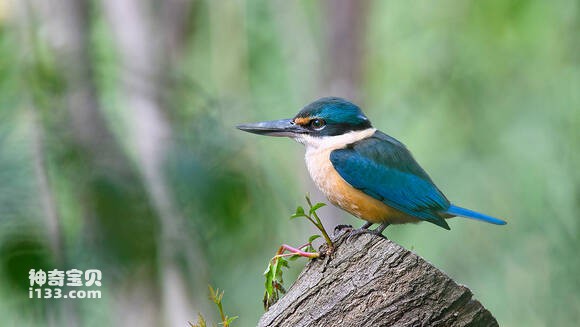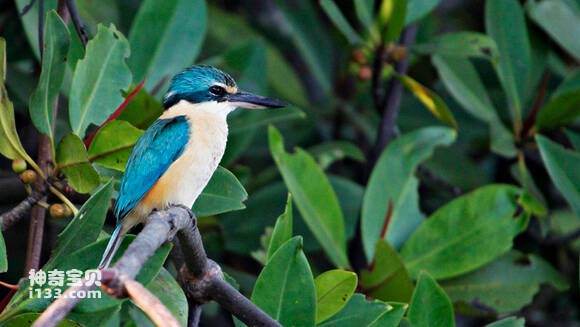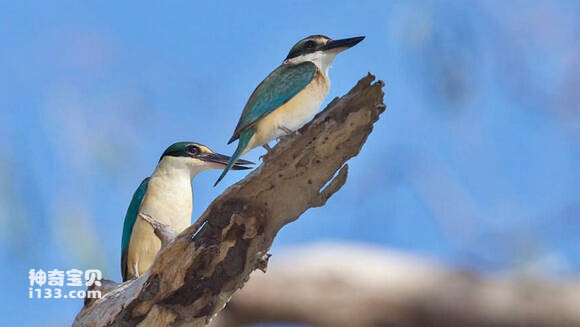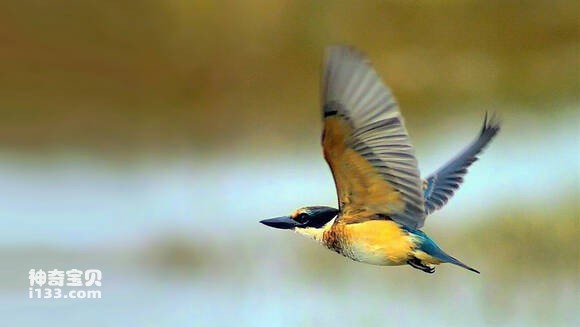Todirhamphus sanctus
IUCN
LCBasic Information
Scientific classification
- name:Todirhamphus sanctus
- Scientific Name:Todirhamphus sanctus,Sacred Kingfisher,Halcyon sancta
- Outline:Climbing birds
- Family:
Vital signs
- length:19-24cm
- Weight:About 65g
- lifetime:About 20 years
Feature
Distribution and Habitat
It is found in Australia, New Guinea, Tasmania, and New Caledonia. It also extends to the Solomon Islands, Tsunami Island, Lord Howe Island, Norfolk Island, Loyalty Island, New Zealand.
It is usually found in heavily wooded areas, such as mangroves, eucalyptus forests or white forests.
Appearance
The body length is 19-24 cm, the weight is 65 g, and the life span is 20 years.
Like all of its kind, it has a large head and a strong neck and shoulders. The lower back of the upper body, the tail is a beautiful turquoise color, and the chest and abdomen of the lower body below the collar are contrasting white and cream colors. The shoulder is shade blue-green. The cheeks are like a black flag, above which are hidden the same black eyes, extending from the ears to the base of the upper mouth, the neck. The sexes are roughly the same, but the females are slightly smaller. [4]
The mouth is thick and long like a chisel, the base is wider, the mouth peak is straight, the peak ridge is round, there is no nasal groove on both sides; Wing circle, the first primary feather is equal or slightly shorter than the seventh primary feather, and the second, third, and fourth are nearly equal in length; Primary feather base with white spots; The tail is round.
Details
Todirhamphus sanctus, Sacred Kingfisher, Halcyon sancta, There are five subspecies (1.Todirhamphus sanctus) found in Australia, the Western Solomons, Indonesia, and Melanesia. 2.Todirhamphus sanctus vagans is found in Norfolk Island and New Zealand. 3.Todirhamphus sanctus canacorum is found in New Caledonia. 4.Todirhamphus sanctus macmillani is found on Loyalty Island. 5.Todirhamphus sanctus recurvirostris is found in Western Samoa.) .

In the wild, the song of the white-browed emerald is very clear, like a flute if it is a friendly appeal, and if it is exclaimed, it sounds like a hoarse rattle. During spawning season, these birds show no fear and are able to chase away mammals or birds larger than them.

Like most forest game kingfishers, the emerald is entirely carnivorous. It often searches for prey in leaves or dirt, and only occasionally catches prey in aquatic environments. The main diet is invertebrates such as crickets, spiders, scorpions, and snails. It also eats small vertebrates such as small fish, small snakes and lizards.
White eyebrows emerald nest on the earth cliff or river dyke, with the mouth digging tunnelled caves for the nest, 60 cm deep, 20 cm wide, 10 cm high long, oval. These caves are generally bare of bedding. The eggs are laid directly on the nest ground. Some also drill holes in tree trunks for nests. Oval, pure white, about 29.4×26.2 mm in size. The spawning is mainly from September to December, occasionally extending to March. Both parents take turns incubating and raising the chicks. After 18 days the eggs hatch and the young have a nesting period of 26 days until they are ready to fly.

Listed in the International Union for Conservation of Nature (IUCN) ver 3.1:2008 Red List of Birds.
Protect wild animals and eliminate wild meat.
Maintaining ecological balance is everyone's responsibility!








